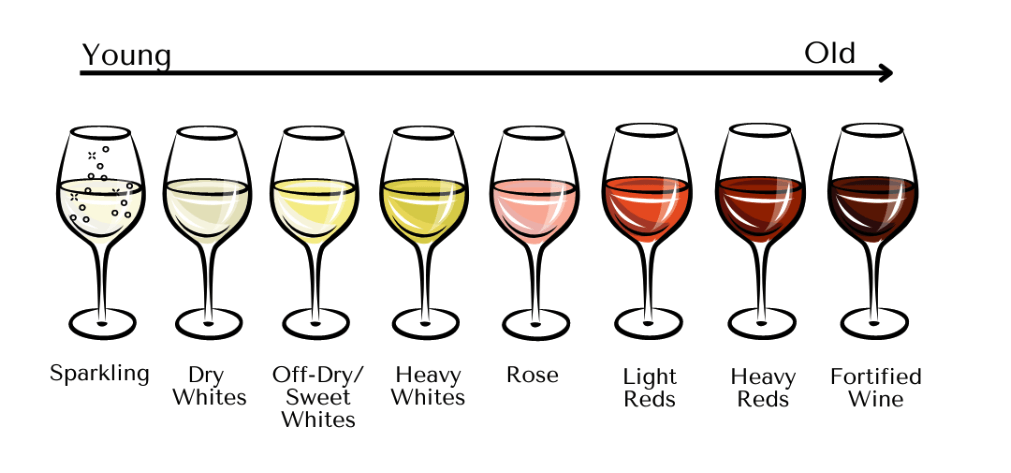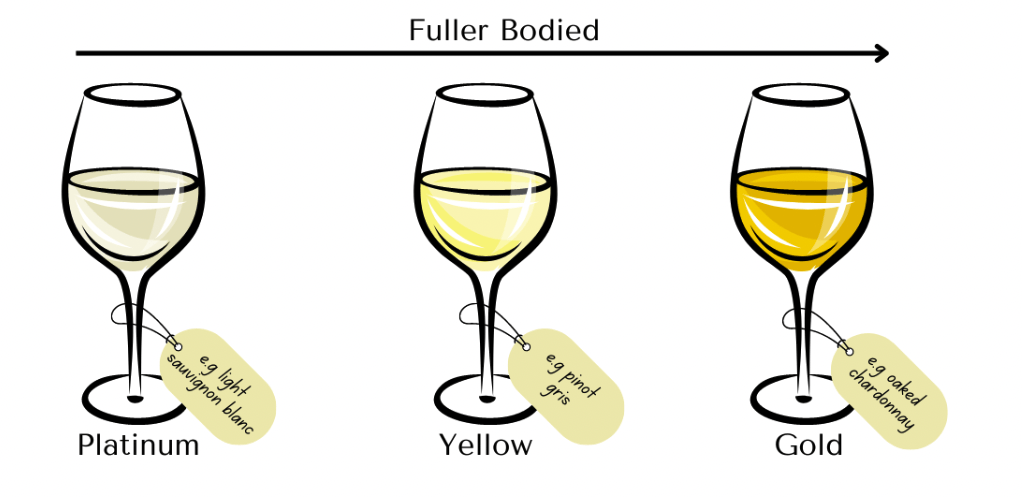A Guide to Wine Tasting: The 5 Ss of Wine Tasting to Look Like a Pro

Tasting wine is different from simply drinking it. The purpose of wine tasting is to truly experience the wine, and that means slowing down and taking your time. Professional wine tasters use words like “angular”, “complex” and “elegant” to describe wine which, to amateaur wine tasters like us, can sound intimidating. Afterall, what does “flamboyant” in a wine really mean?
If you want to look and sound more like a professional and impress your friends with your sophisticated wine tasting skills, follow these
tips and you’ll be able to get the most out of any glass. Not only will you enjoy the wine more, but you’ll gain an appreciation for it and experience the wine in a whole new way!
What role do our 5 senses play in appreciating wine?
When you think of wine tasting, you might assume that the actual taste of the wine is the most important step. However, taste is only one of our five senses, and the process of wine tasting involves 4 of our senses to observe the sights, smells, sensations, and tastes each wine brings. We see the wine, we smell it, we taste it, and of course we touch it. Each sense combines to form a sensory journey taking you through the attributes of the wine.
How to taste wine in the correct order
Wines should be tasted in a specific order to maximise their flavours. Out of order, the tastes of some wines can diminish the tastes of those that follow. For example, the delicate flavours of a light Pinot Gris will get lost if tasted after a heavy, oaked Chardonnay.
These are the few basic rules to follow:
- Whites Before Red
- Light Body Before Heavy Body
- Dry Before Sweet
- Young Before Old
- End with Fortified

The 5 Ss of wine tasting
Following these five steps each time you taste a new wine will help you break down the wine’s structure and identify its key characteristics, allowing you to get to know your palate better, eliminate characteristics in wines you don’t enjoy, and identify new wines you love.
- See
- Sniff, Swirl, Sniff
- Sip, Swirl, Swallow
- Savour
- Summarise
1. SEE
Before you taste wine, you want to take a good look at it. The wine’s colour intensity in the glass can tell you a lot about it, from its acidity and tannin content, to its age and body.
In natural lighting, look down into the glass through the wine. You’ll be able to see the depth of colour and, with experience, you’ll even be able to recognize the grape variety by the colour intensity. Next, tilt the glass against a light background such as a white tablecloth so there’s no colour distortion and look at it from the side. Avoid holding the glass up to light and looking through the wine from beneath.The wine should be completely clear. Some mature red wines produce a natural sediment which is totally safe to drink but it can change the smell and taste of the wine. If there is sediment, let the bottle rest until the sediment settles.
Look for the wine’s age
As white wine ages, it darkens from a straw colour to a deep golden colour. Red wine, on the other hand, gets lighter in colour as it ages, transforming from a ruby red to more of a rusty orange. You’ll be able to notice this colour difference best when tilting your wine glass over a white surface and observing the wine’s colour near the rim.
Look for the wine’s body
Wine body is how heavy and rich a wine tastes, and it is determined by a combination of several factors including grape variety, alcohol level, and even sweetness level. As a rule of thumb, wines that are deeper in colour will be fuller-bodied than wines that are lighter in colour. Generally, you’ll find Sauvignon Blanc, Pinot Grigio and sweet Riesling fall into the light bodied white wine category. Pinot Gris, Dry Riesling and Unoaked Chardonnay are medium bodied, and oaked Chardonnay, Viognier, and Muscats are full-bodied white wines.
Tilt the glass, observe how the liquid and the glass interact. Wines that are high in alcohol content or dense and rich with tannins or sugar will stick to the sides more.

In this diagram, you can see that moving from left to right, the white wine is increasing in colour intensity, meaning the wines to the right are most likely fuller-bodied than the wines to the left.
Look for the wine’s acidity
Red wines with higher acidity are more likely to be a bright ruby colour, whereas less-acidic red wines can take on a blue, purple hue or even brown.
2. Sniff, Swirl, Sniff
Step 2 involves two very important S’s - Sniff and Swirl.
Sniff
Once you’ve had a good look at your wine, take a deep sniff. Tilt the glass toward you and stick your nose into the top of the glass. It can be intimidating at first but don’t be afraid to get your nose right in there! This first sniff of the wine is not the most important one. It’s a good test to see how the next step, swirling the wine, can change the flavours that you smell.
Swirl
After your initial sniff, swirl the wine in the glass for 10-20 seconds to release the “hidden” aromas of the wine. Practice with water first if you don’t want to risk spilling valuable wine! When you move onto swirling real wine, make sure there is plenty of room between the wine and the rim. Grip the base of the stem of the glass between your thumb and forefinger, and gently move the glass almost as if you’re writing with a pen. Always hold your wine glass by the stem rather than the bowl so that you are not obstructing your view of the wine you’re tasting, nor warming up the wine with your hand which impacts its taste.
Sniff Again
After swirling your wine, sniff it again. First, hover your nose above the glass and take a few quick sniffs. Then get closer to the glass and inhale deeper. Keep your mouth slightly opened and try to inhale the wine’s aromas through your nose and exhale through your mouth. You should notice quite a difference after the wine has been aerated and you may even be able to pick up specific notes in the wine on the nose. Keep in mind that people have different senses of smell so you may not detect the same notes as other people. That being said, have you ever read a wine description and wondered how on earth those flavours were picked up? For example, Dirty Laundry’s 2018 Bordello is described as tasting of “brandied cherries, fig, ripe cherries, & a hint of mint” and “Saskatoon berry, mulberry, cedar, star anise & sour cherry Danish”. Wine tasting is definitely an art, and it takes practice. The more new wines you try, the more advanced your palate will become.
Ultimately, there are three levels of wine that you should try to identify:
- Primary aromas are usually fruity, floral, herbal or spicy, and come from the grapes themselves. These aromas are impacted by the type of soil the grape was grown in, the sun exposure it had etc.
- Secondary aromas are produced from stages during the winemaking process such as fermentation and malolactic fermentation. Aromas can include specific yeast, mushroom, and earth smells and of course the oak from the ageing of a chardonnay.
- Tertiary aromas are the more subtle scents and they usually develop with the ageing of the wine. For example, over time the fresh fruit aromas will become more dried, stewed or even nutty.
3. Sip, Swirl, Swallow
Finally, it's time to taste the wine! While the flavours you experience should be a natural continuation of the aromas you identified in the previous step, sipping the wine reveals a whole new array of sensations and flavours to analyse. If you are experimenting with food and wine pairing, note which flavours change or develop as you match the wine with different cuisines.
Take a sip of your wine and swirl it gently around in your mouth to ensure the wine fully coats your tastebuds and the flavour is fully absorbed. Open your mouth slightly to allow some air into your mouth at the same time, further aerating the wine on the palate.
When sipping the wine, evaluate it from several different angles:
The wine’s sweetness
The main purpose of sugar in grapes is to be converted to alcohol (by yeast). Sweetness is one of the first sensations on your tongue, determined by the wine’s residual sugar levels - leftover sugar from the fermentation process. This can be anywhere between 0 g/L to 220 g/L. A dry wine will have less than 10 g/L of residual sugar. Wine that is sweeter than dry wine is often referred to as off-dry. True “sweet wine”, like a moscato or ice-wine has very high residual sugar levels.
Tip: A wine’s fruity smell can often confuse new wine tasters into thinking a wine is sweeter than it actually is. Try plugging your nose while sipping on the wine. You’ll get a more accurate taste of the sweetness.
The wine’s acidity
Acid in wine is needed for long-term ageing. Without it, wine is more prone to contamination. Grapes grown in cooler climates naturally contain higher amounts of acid because they are exposed to less warmth and sunshine to increase grapes’ sugar and pH levels. In warmer climates, tartaric acid might be added to the grape juice before fermentation as the amounts of natural acid in the grapes are much lower.
A wine that has high acidity will usually taste crisper and more tart on the palate, whereas without acid, wine can taste flat. Our mouths react instinctively to acidity levels so if it feels like your mouth is watering as you taste the wine, it’s a more acidic wine.
The tannins in the wine
Tannins - primarily present in red wine - occur naturally in a grape's skins, stems, and seeds, and they help provide texture, balance, and structure to wine. Whereas acidity leaves more of a tart, sour taste in the mouth, tannins leave a more dry, bitter taste. Tannins do soften out overtime and are a crucial component in the ageing process of wine.
Tip: A wine’s tannins can be lessened when paired with a fatty or oily dish.
The alcohol in the wine
Alcohol is the direct product of yeasts eating sugars during the process of fermentation. Too much alcohol and your wine might leave you with a slightly burning taste in your mouth.
The texture and body of the wine
We’ve talked about a wine’s body in appearance, but in terms of taste it refers to the weight of the wine on the palate. A heavy wine with a high alcohol content will have a fuller body, whereas wines with a lower alcohol content will be lighter. Swirl the wine gently in your mouth and try to understand how it feels. Is it a syrupy and heavy wine or a light and fruity one? A light-bodied wine such as Pinot Grigio or Sauvignon Blanc will feel much lighter in your mouth than a Chardonnay, for example.
The finish of the wine
For high-quality wines, the tasting doesn't stop at the swallow. A good wine’s flavour will go on and on. This is called the finish - how long the wine’s flavours linger, evolve, and develop on your palate after you’ve taken a sip. A lower quality wine, one that is not well-balanced, will have an unpleasant finish.
The balance of the wine
A wine is balanced when each of the elements above are harmonious and no single element dominates. The acidity and tannins should balance the sweetness, fruit and alcohol.
4. Savour
Wine is best when sipped and savoured, as opposed to being gulped down. To truly savour the wine, think about what is standing out to you. Do you particularly enjoy the wine’s fruitiness? Or is the body your favourite part on the palate? Try to assess how long the taste lasts and what the finish is. Is it a long or short finish? What are the main aftertaste notes? How does the wine change with every sip as it sits in the glass and is exposed to more air and warmth?
5. Summarise
Summarising the wine tasting experience of each wine you taste will help you in the future seek out wines that suit your palate and are a fit with your personal preferences. Was there something unique about the wine that impressed you? Overall, did you like it or not, and why not. Would you recommend it to someone else? Take notes on the key flavour and tasting note hints, aromas, and sensations you’ve experienced.
Practice and perfect your wine tasting skills
A great way to take your wine tasting skills from amateurish to bordering on expert is to attend more wine tasting events. Not only can they be a ton of fun, but you can hone your tasting skills, learning to recognize the vast array of wine flavours and aromas. The Okanagan Wine Festivals Society (OWFS) puts on Fall and Spring events in the Okanagan wine region (named by USA Today as the world's second-best wine region to visit), providing a unique wine experience to attendees.
Visiting local wineries in the off-season (when they are much quieter) is also another great opportunity to perfect your palate, and being quieter you can usually spend more time chatting with tasting room staff to tap into their knowledge and get some valuable wine-tasting tips.
Once you’ve refined your palate, why not try a blind wine tastings where you are unaware of anything about the wine that you are tasting. The label, origin, price, etc. are all unknown. It can be a fun way to see how much you’ve learned about wine in your tasting journey to date and is the perfect way to delve deeper into the world of wine and understand the different
nuances between specific wine styles.
Ultimately, tasting wine is supposed to be a fun experience. While there are “rules” that will enhance the experience, at the end of the day it’s your experience, your palate, and rules are sometimes made to be broken!

